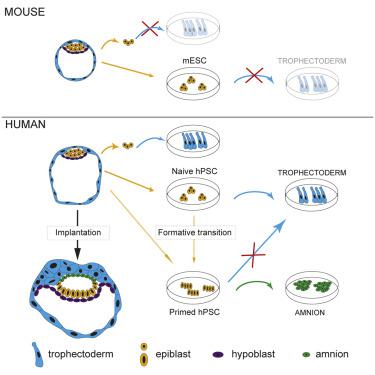Cell Stem Cell ( IF 19.8 ) Pub Date : 2021-04-07 , DOI: 10.1016/j.stem.2021.02.025 Ge Guo 1 , Giuliano Giuseppe Stirparo 1 , Stanley E Strawbridge 2 , Daniel Spindlow 2 , Jian Yang 3 , James Clarke 2 , Anish Dattani 1 , Ayaka Yanagida 1 , Meng Amy Li 2 , Sam Myers 2 , Buse Nurten Özel 2 , Jennifer Nichols 4 , Austin Smith 5

|
Classic embryological experiments have established that the early mouse embryo develops via sequential lineage bifurcations. The first segregated lineage is the trophectoderm, essential for blastocyst formation. Mouse naive epiblast and derivative embryonic stem cells are restricted accordingly from producing trophectoderm. Here we show, in contrast, that human naive embryonic stem cells readily make blastocyst trophectoderm and descendant trophoblast cell types. Trophectoderm was induced rapidly and efficiently by inhibition of ERK/mitogen-activated protein kinase (MAPK) and Nodal signaling. Transcriptome comparison with the human embryo substantiated direct formation of trophectoderm with subsequent differentiation into syncytiotrophoblast, cytotrophoblast, and downstream trophoblast stem cells. During pluripotency progression lineage potential switches from trophectoderm to amnion. Live-cell tracking revealed that epiblast cells in the human blastocyst are also able to produce trophectoderm. Thus, the paradigm of developmental specification coupled to lineage restriction does not apply to humans. Instead, epiblast plasticity and the potential for blastocyst regeneration are retained until implantation.
中文翻译:

人类幼稚外胚层细胞具有不受限制的谱系潜力
经典的胚胎学实验已经证实,早期小鼠胚胎是通过连续的谱系分叉发育的。第一个分离的谱系是滋养外胚层,对于囊胚的形成至关重要。小鼠幼稚外胚层和衍生胚胎干细胞产生滋养外胚层的能力相应受到限制。相比之下,我们在这里表明,人类幼稚胚胎干细胞很容易形成囊胚滋养外胚层和后代滋养层细胞类型。通过抑制 ERK/丝裂原激活蛋白激酶 (MAPK) 和 Nodal 信号传导,快速有效地诱导滋养外胚层。与人类胚胎的转录组比较证实了滋养外胚层的直接形成,随后分化为合体滋养层、细胞滋养层和下游滋养层干细胞。在多能性进展过程中,谱系潜能从滋养外胚层切换到羊膜。活细胞追踪显示,人类囊胚中的外胚层细胞也能够产生滋养外胚层。因此,与谱系限制相结合的发育规范范式不适用于人类。相反,外胚层的可塑性和囊胚再生的潜力一直保留到植入。































 京公网安备 11010802027423号
京公网安备 11010802027423号